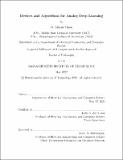Devices and Algorithms for Analog Deep Learning
Author(s)
Onen, O. Murat
DownloadThesis PDF (34.89Mb)
Advisor
del Alamo, Jesús A.
Terms of use
Metadata
Show full item recordAbstract
Efforts to realize analog processors have skyrocketed over the last decade as having energy-efficient deep learning accelerators became imperative for the future of information processing. However, the absence of two entangled components creates an impasse before their practical implementation: devices satisfying algorithm-imposed requirements and algorithms running on nonideality-tolerant routines. This thesis demonstrates a near-ideal device technology and a superior neural network training algorithm that can ultimately propel analog computing when combined together. The CMOS-compatible nanoscale protonic devices demonstrated here show unprecedented characteristics, incorporating the benefits of nanoionics with extreme acceleration of ion transport and reactions under strong electric fields. Enabled by a material-level breakthrough of utilizing phosphosilicate glass (PSG) as a proton electrolyte, this operation regime achieves controlled shuttling and intercalation of protons in nanoseconds at room temperature in an energy-efficient manner. Then, a theoretical analysis is carried out to explain the infamous incompatibility between asymmetric device modulation and conventional neural network training algorithms. By establishing a powerful analogy with classical mechanics, a novel method, Stochastic Hamiltonian Descent, is developed to exploit device asymmetry as a useful feature. Overall, devices and algorithms developed in this thesis have immediate applications in analog deep learning, whereas the overarching methodology provides further insight for future advancements.
Date issued
2022-05Department
Massachusetts Institute of Technology. Department of Electrical Engineering and Computer SciencePublisher
Massachusetts Institute of Technology